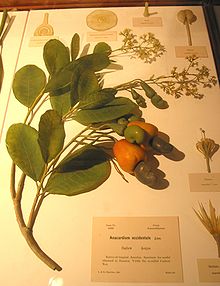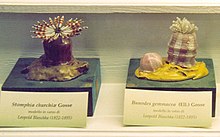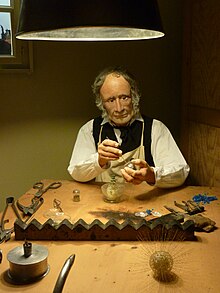Glass models of the Blaschkas


The glass models of the Blaschkas are a famous collection of very realistic glass representations of botanical and zoological motifs.
The Blaschkas
Leopold Blaschka
Leopold Blaschka was born in 1822 in Böhmisch Aicha in northern Bohemia . He completed an apprenticeship as a goldsmith and a glassblower . For the latter, he developed glass spinning, which makes the finest work possible. But he also cut stones and metals. He later went into business for himself by producing glass eyes .
His wife died in the early 1850s. In May 1853, Blaschka traveled to the USA on a sailing ship because his health was bad and he wanted to cure it during the voyage. In America he wanted to work as a craftsman for a few months. After his return he married a second time. He died in 1895, his grave is in the Hosterwitzer cemetery in Dresden.
Rudolph Blaschka
His son Rudolph (also Rudolf) Blaschka was born in 1857. The parents wanted their son to have the best possible school education, so the family moved to Dresden in 1863 . Here she changed her place of residence a few times (Kleine Schießgasse 2, from 1877 Kaulbachstrasse 11) before moving into a house with a workshop in Hosterwitz . At that time the place did not belong to the city.
Rudolph Blaschka dealt intensively with the flora of Central Germany as well as the fauna of the Mediterranean, the North and Baltic Seas. He regularly visited the specialist library of the Leopoldina . In 1880 he became a corresponding member of the Isis Scientific Society . In 1892 and 1895 he traveled to the United States to study. However, his second trip was interrupted by the death of his father. On his travels, the young Blaschka had made several hundred drawings and notes on the appearance, color differences, hairiness and other peculiarities of American plants.
He died in 1939, leaving behind his wife (but no children). Like his father, he was buried in the Hosterwitz cemetery and noted in the death books of the Maria am Wasser community .
The work
The Blaschkas became famous for making hundreds of glass models of marine animals and plants.
The impetus for this was presumably an Englishman who asked Leopold Blaschka around 1863 whether it would be possible to blow sea anemones out of glass for an aquarium, "because these animals are so ephemeral". Blaschka complied with the request and soon focused his work only on glass blowing.
Until 1880
In 1871 Leopold published his first catalog in which he praised his works for “maritime aquariums” and as “an ornament for elegant rooms”. In the following period, up to around 1880, he modeled - from around 1875 also together with his son - a collection of around 700 models of invertebrate marine organisms and thousands of individual pieces, which were sold in around 70 countries on almost every continent (e.g. Japan, Italy, England , Poland, Russia, Australia and India). Because of their level of detail, the glass models of the Blaschkas were coveted objects for illustration and study in schools and universities, as there were as yet no effective preservatives for real living beings.
As mentioned above, the Blaschkas had largely drawn the templates for the works themselves. However, they also made use of the very precise drawings by Ernst Haeckel . Over 1,900 zoological glass models were created in almost 17 years.
Until 1939
From around 1881 the glassblowers concentrated almost exclusively on the production of botanical models. In 1886, they signed a contract with Professor Goodale of Harvard University in the United States for the delivery of several thousand glass flowers to the university.
In 1890 another 700 animal models were made. Three years later, the Bohemian glassblowers were allowed to present their work at the World's Columbian Exposition in Chicago . After Leopold Blaschka's death, his son continued the work until around 1936.
Storage and current situation
Not all glass models have survived the decades. Transport, storage and, in some cases, the chaos of war resulted in numerous losses. Below are some places that are known to host or host some of the Blaschka's work:
zoology
- The Botanical Museum of the Natural History Society in Boston has 100 models of jellyfish, sea snails and other marine animals .
- 32 teaching models of marine invertebrates (jellyfish) are in the zoological collection of the Museum of the University of Tübingen MUT .
- Two exhibits were in the Royal Zoological Museum in Dresden , later Zoological Museum . They were destroyed in World War II.
- According to its own information, the University of Pisa also has 52 models of marine animals. A good half of them can be viewed in the Museo di Storia Naturale e del Territorio , which is housed in a side wing of the Carthusian monastery Certosa de Pisa near Calci .
- In the Natural History Museum Vienna , since autumn 2016, in addition to its own models, loans from the 146-piece collection of the University of Vienna have been on display. The university had already shown some pieces there in a special exhibition in 2015. Other models are still in the university's collections.
- The Kremsmünster Abbey has the largest collection of Blaschkas' glass animals in Austria.
- The Natural History Museum in London houses a collection of 187 models of marine invertebrates.
- 94 models of marine animals are in the collection of the Natural History Museum of the City of Geneva . Some of these models will be presented to the public in a permanent exhibition opened in 2008 in the Salle Blaschka.
- The Zoological Museum at Trinity College Dublin also exhibits glass models of marine animals.
- The University Museum Utrecht (Netherlands) has 86 glass animals.
- In the US, v. a. Mention should be made of the Corning Museum of Glass , which showed its “Blaschkas” in 2016/17 under the title “Fragile Legacy” in a special exhibition.
botany
- Around 60 models of orchids ended up in the Liège State Museum . They fell victim to a fire.
- In Berlin , there are still 32 models in Goerlitz and Gotha three in Rostock nine and in Leipzig six.
- The largest coherent collection of glass models of the Blaschkas can be found today in the Harvard Museum of Natural History at Harvard University, which, according to a new inventory, contains 4,300 botanical objects. This collection is one of the most popular Harvard University attractions, attracting over 10,000 visitors annually (Schultes, RA & Davis, WA: The Glass Flowers at Harvard. Harvard 2004, pp. Vii, 16). Web presentation of the glass flowers: http://hmnh.harvard.edu/glass-flowers
recognition
Even today, the skills of the Blaschkas are unmatched. Even researchers at Harvard University could not understand the manufacturing techniques in every detail. Since the Blaschkas did not train any apprentices, the knowledge about the production of these models was lost.
In recognition of the services to the university, Harvard University continues to fund the care of the family's graves in Hosterwitz to this day.
inspiration
Today it is believed that Leopold Blaschka was inspired to create the marine world in glass on his trip to the USA, or rather on the crossing. The sailing ship he was on was held in a slack for two weeks. During this time he observed sea lights , which obviously fascinated him very much. He wrote about this in his notes:
- “We are on a sailing ship in the Atlantic Ocean, banned by the calm. A point in bright greenish light appears right in front of us, which is getting bigger and bigger. With all this, a dark point, probably a fish, scurries through the glowing creatures. It is as if they wanted to lure the delighted observer into a fairy realm. "
It can be assumed that Blaschka never lost her enthusiasm for the play.
Others
Today the Society for Natural Science Glass Art - Blaschka-Haus e. V. around a museum memorial that documents the work of the glass artists Leopold and Rudolf Blaschka. He also provides information about the life and work of the two artists.
literature
- Martin Lindner, Heidi Koch, Hans-Jürgen Koch: Be careful, creatures made of glass! In: GEO . Hamburg, 12 (December) 2006. ISSN 0342-8311
- Martin Rasper, Heidi Koch, Hans-Jürgen Koch: Shimmering beauties - marine animals made of glass . In: Nature & Cosmos. Leinfelden-Echterdingen 3, 2008. ISSN 0723-5038
- Municipal Museum Rheydt, Dr. Karlheinz Wiegmann, Désirée Klar: Chamber of Wonder of the Seas - The glass models of the Blaschkas . In: Magazine for the exhibition City of Mönchengladbach, 2015, ISBN 978-3-925256-74-5 .
Individual evidence
- ^ Press release by the NHM. Retrieved November 28, 2016 .
- ↑ The exhibition tells of the "knowledge of things". In: ORF.at. May 5, 2015, accessed April 7, 2016 .
- ↑ Object of the month January 2017. Retrieved on January 30, 2017 .
- ↑ Object of the month 01/1998. Retrieved November 28, 2016 .
- ↑ Blaschka glass models. Natural History Museum, London, accessed April 7, 2016 .
- ↑ Modèles en verre à l'honneur. dossier de press. Muséum d'histoire naturelle, Genève, accessed on April 7, 2016 (French).
- ↑ Salle Blaschka: Exposition permanente ouverte en juin 2008. Muséum d'histoire naturelle, Genève, accessed on April 7, 2016 (French).
- ^ The Zoological Museum. Trinity College Dublin, accessed April 7, 2016 .
- ↑ Pareltjes van glass. Retrieved on November 28, 2016 .
- ^ Fragile Legacy: The Marine Invertebrate Glass Models of Leopold and Rudolf Blaschka. Retrieved November 28, 2016 .
Web links
German collections :
- Website of the Blaschka Haus e. V.
- Presentation of the Blaschkas on the Urania website in Dresden ( Memento from June 8, 2002 in the web archive archive.today )
American collections in English:
- Out of the teeming sea: The Cornell Collection of Blaschka Invertebrate Models
- Blaschka Marine Invertebrates at Cornell University
- Corning Museum
- Harvard University: These creatures see dusty duty
- Harvard University: Eclipsed for decades, Harvard's glass animals step out
- Harvard University: Care for Glass Flowers branches out
English collections in English:
- Natural History Museum, London
- National Museum of Wales
- Blaschka models at the Grant Museum, University College, London
Italian collections in Italian:







